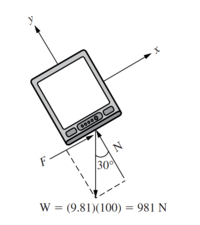coooool222
Junior Member
- Joined
- Jun 1, 2020
- Messages
- 93
They are multiplying by sine and cosine to obtain the components of W relative to x and y coordinates that they apparently failed to identify, so part of your misunderstanding is their fault -- unless you have omitted the vector diagram that should show those things.Why are they multiplying the weight by the sin and cosine of the 30-degree angle?
Isn't weight not affected by anything since it's constant?
No; it's because the friction force is parallel to the ramp.Also is the angle of friction 0 because it's a straight line?
oh yeah i forgot about the diagram, hereThey are multiplying by sine and cosine to obtain the components of W relative to x and y coordinates that they apparently failed to identify, so part of your misunderstanding is their fault -- unless you have omitted the vector diagram that should show those things.
It appears that x is taken as parallel to the ramp, and y is perpendicular to it.
No; it's because the friction force is parallel to the ramp.
If you did omit a vector diagram, please show that to us, so we can help you read it.

Is everything clear now, or do you need any further explanation of the diagram?oh yeah i forgot about the diagram, hereView attachment 36599
